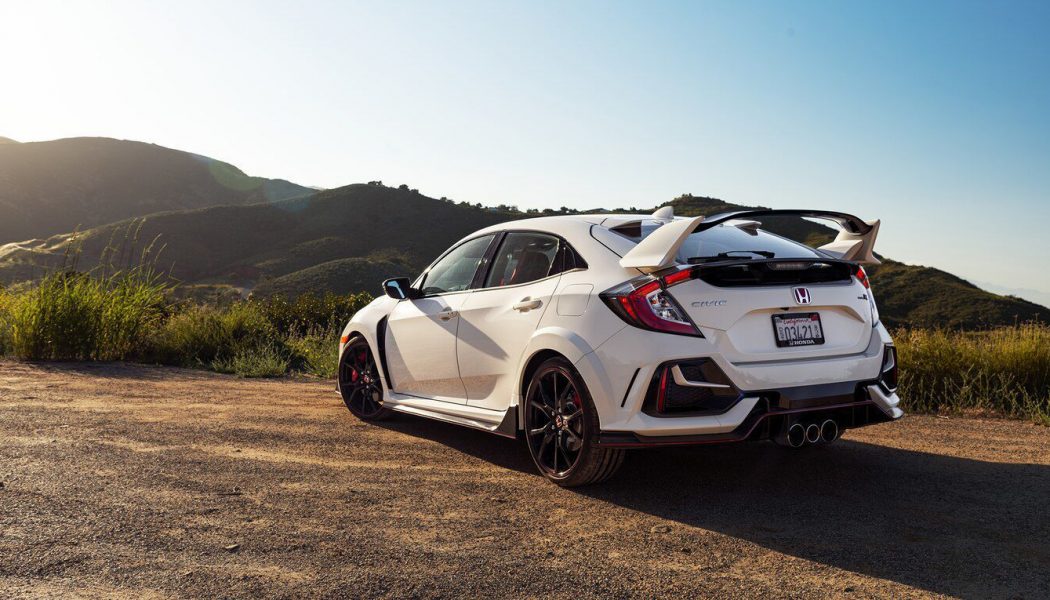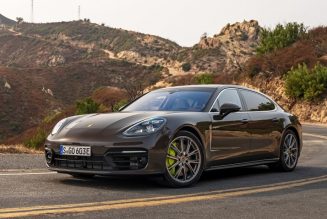Since its 2017 debut, 13,000 individually numbered Honda Civic Type Rs have found their way into enthusiasts’ embraces. We lived with a 2018 “CTR” for a year and didn’t want to give it back. A mild update occurred in 2019, but for 2020, substantive changes make our favorite hot hatch even better. To answer your first question: “Does the 2020 Civic Type R get a boost in power?” No, the 2.0-liter turbo-four makes the same 306 horsepower and 295 lb-ft, which is plenty. Yet the no-options singular-trim CTR gets a modest $695 price increase over last year, but that nets a host of hard- and software upgrades and an additional, exclusive Boost Blue paint job.
Magic Carpet: the 2020 Civic Type R’s adaptive dampers
Honda reports that the sampling rate of the updated Type R’s adaptive dampers gets a ten-fold improvement, meaning rather than twice per second, signals and adjustments now occur 20 times per second (20 Hz). I can assure you, the city did not repave my neighborhood’s patchwork pavement, but it seemed to have. Especially in Comfort mode, the CTR has always smoothed out busy surfaces, a quality few sports cars, much less a hot hatch with 20-inch wheels and tire sidewalls that are less than 3 inches tall should be able to do. It does it even better now. Uneven pavement, dips, and even the harsh impacts it once abhorred are taken in stride now. Sure, there’s still tire noise on L.A. ‘s grooved concrete freeways, but we forgive even 911 Carreras for that.
Head for the Hills: the Civic Type R’s updated suspension
Meanwhile, Honda says that selectively stiffening front and rear suspension bushings, along with more rear toe-in geometry, should improve lateral grip by ensuring more tire contact patch remains on the pavement. Up front, a new lower friction ball joint should improve feel and precision. And all combined with that 20 Hz damper system, Honda says they have implemented electronic controls on individual dampers (both compression and rebound) that should improve turn in, reduce mid-corner roll, and plant the car for improved exits. Mission accomplished across the board: sharper without being harsher.
Indeed, the new CTR points into an apex more aggressively while steering feel/feedback are improved. Snaking up a familiar road we use often, I felt like the car knew the way as well as I did. By the seat of my test driver’s calibrated pants, I’m sensing more cornering grip available from the same Continental SportContact 6 tires. I could roll into and then stomp on the throttle pedal far earlier on the exits. Wow; I wasn’t expecting such a noticeable difference. The balance and confidence this car supplies remain uncanny, but Honda has really taken it to a new level for 2020. I can’t wait to take it to a racetrack and see how much quicker its lap time will be.
Track Time: Making the 2020 Civic Type R track ready
Engine cooling during repeated laps has been a known issue when tracking the Civic Type R since its introduction. We witnessed it reducing power to lower operating temperature by losing 0.5 second per lap on a 1.6-mile road course. The first lap, at least with Randy Pobst driving, was always the quickest. The third lap would be a full second slower, and so on. To address this, Honda redesigned the grille to allow 13 percent more air flow and replaced the radiator. This is said to reduce the coolant temperature by close to 20 degrees Farenheit in “high-demand” situations. We’ll have to wait and see on this one, but so far Honda’s claims keep bearing fruit.
For the same reasons, Honda also replaced the Type R’s one-piece vented/drilled front brake rotors with lighter, floating two-piece rotors that should more quickly dissipate heat. Combined with new pads, free travel of the brake pedal has been reduced by 17 percent. Honestly, I noticed this, and it was one of my teensy criticisms of the previous car. As aggressive as it could accelerate and corner, I wanted a bit more aggression in the braking department. Done, and thank you.
Interior Bits: The Civic’s cabin
Not that it needed it, but Honda replaced the aluminum ball shifter with a slightly smaller, oblong one and counterweighted the lever. It still gets hot/cold as a result of the ambient conditions, and I did not notice any improvement in the already slick shifts. They also replaced the leather steering wheel and shift boot with faux suede. The infotainment head unit was replaced last year to include hard buttons and a volume knob. However, it’s still a little finicky and won’t let you access some screens while driving. Like so many carmakers do, Honda added what it calls Active Sound Control that varies the intensity of enhanced engine sounds through the speaker depending on drive mode. Boo, I know, but it actually sounds natural and appropriate. Finally, like Porsche offers, the 2020 CTR gets a smartphone-based performance app. In a news post, we noted, “The app, which is available in both Apple iOS and Android formats, will sync with all 2020 Civic Type R models and monitor 15 different data points in an attempt to make performance drivers better at their craft.” I didn’t try it, but when we get back to vehicle testing, we’ll let you know how precise it proves to be.
Safety Upgrades: Is the Honda Civic Type R Safe?
The Civic Type R now comes with Honda Sensing as standard, plus auto high beams. This means you get radar-based adaptive cruise control, forward collision warning, and if needed, automatic braking, lane departure warning/lane keeping assist, and road departure mitigation. The Civic Type R’s cruise control was a bit laggy before, so that part remains, but the lane departure warning and automatic braking are a bit hyperactive for L.A. ‘s patchwork roads and traffic patterns. The lane keeping assist is solid and doesn’t ping-pong from lane line to lane line.
Deal of the Decade: How much does the 2020 Civic Type R cost?
Whether you think $37,950 is too much to pay for a Honda Civic, even one as thrilling and capable as the record-setting Type R, the slight increase in price over last year is well worth it. The front brakes alone must be worth $695. That it received a much-needed cooling system rethink, noticeable improvements in grip and handling without sacrificing ride, plus the entire safety suite for such a little bump in price is compelling to say the least. The best hot hatch money can buy just got better.
| 2020 Honda Civic Type R | |
| BASE PRICE | $37,950 |
| LAYOUT | Front-engine, FWD, 4-pass, 4-door hatchback |
| ENGINE | 2.0L/306-hp/295-lb-ft turbo DOHC 16-valve I-4 |
| TRANSMISSION | 6-speed manual |
| CURB WEIGHT | 3,100 lb |
| WHEELBASE | 106.3 in |
| L x W x H | 179.4 x 73.9 x 56.5 in |
| 0-60 MPH | 5.4 sec (MT est) |
| EPA FUEL ECON | 22/28/25 mpg |
| ENERGY CONSUMPTION, CITY/HWY | 153/120 kW-hrs/100 miles |
| CO2 EMISSIONS, COMB | 0.80 lb/mile |
| ON SALE | Currently |
More Videos








